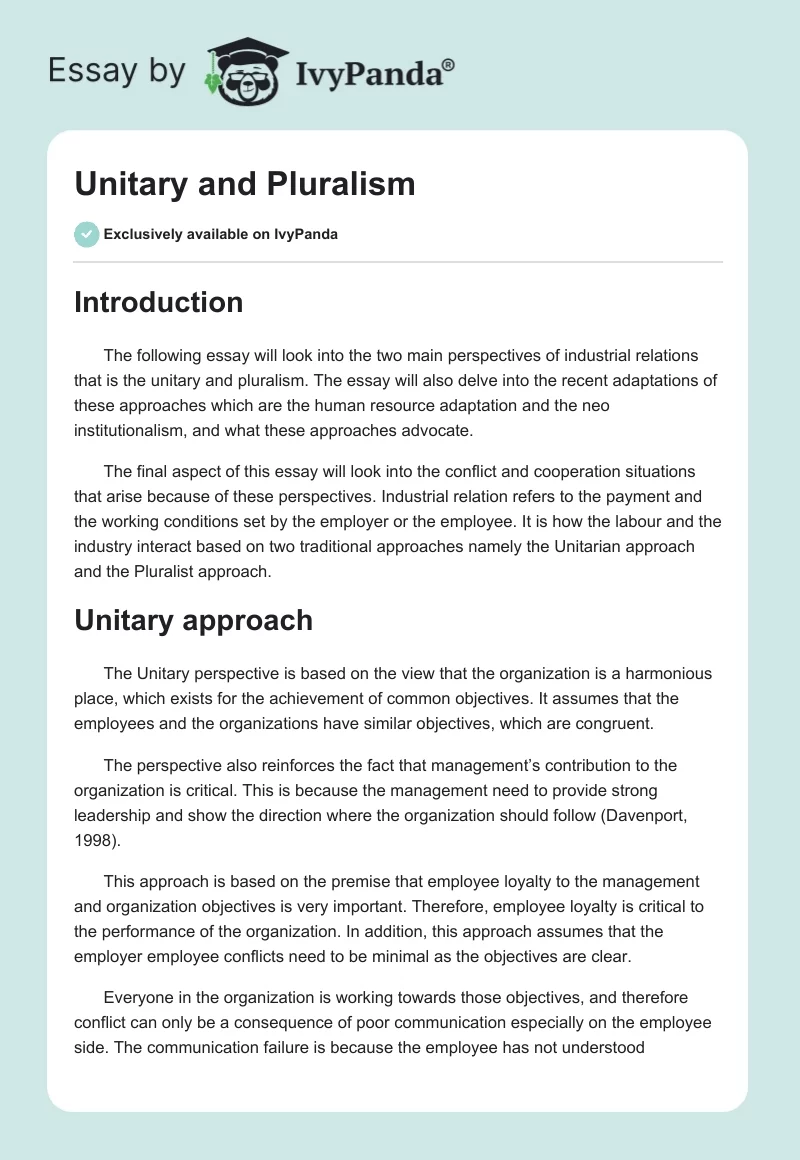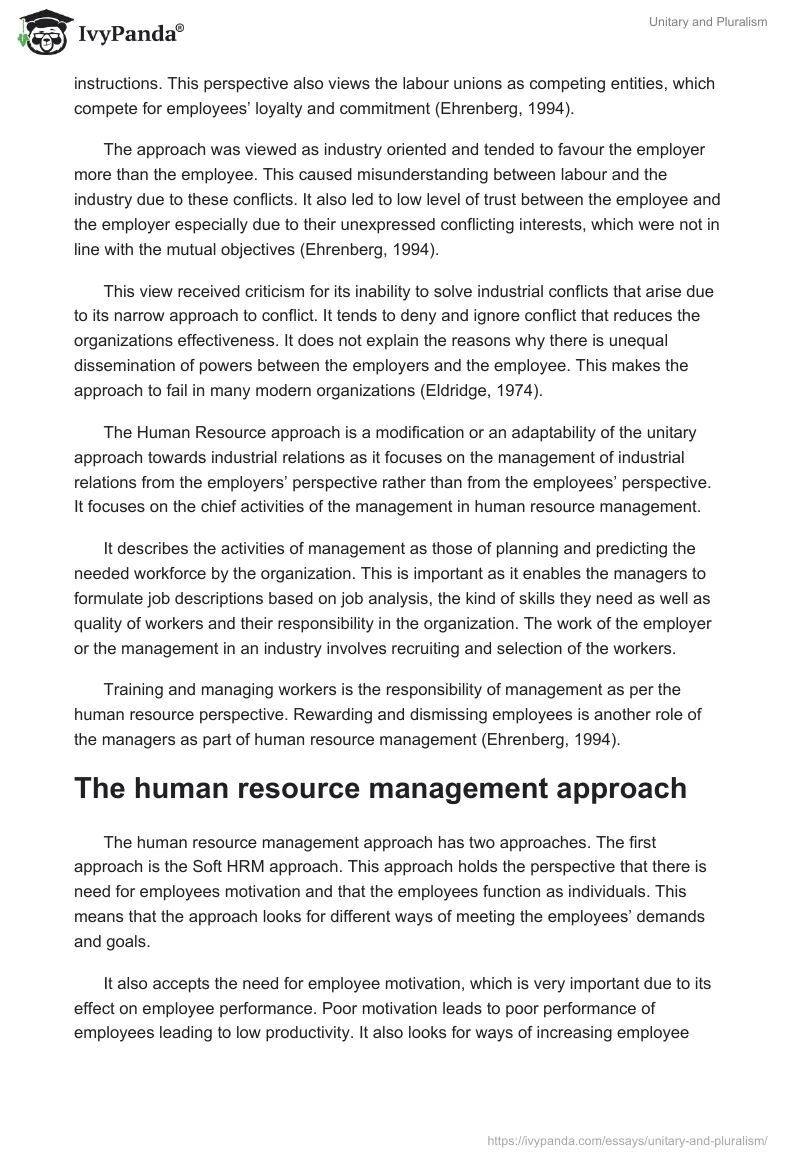Introduction
The following essay will look into the two main perspectives of industrial relations that is the unitary and pluralism. The essay will also delve into the recent adaptations of these approaches which are the human resource adaptation and the neo institutionalism, and what these approaches advocate.
The final aspect of this essay will look into the conflict and cooperation situations that arise because of these perspectives. Industrial relation refers to the payment and the working conditions set by the employer or the employee. It is how the labour and the industry interact based on two traditional approaches namely the Unitarian approach and the Pluralist approach.
Unitary approach
The Unitary perspective is based on the view that the organization is a harmonious place, which exists for the achievement of common objectives. It assumes that the employees and the organizations have similar objectives, which are congruent.
The perspective also reinforces the fact that management’s contribution to the organization is critical. This is because the management need to provide strong leadership and show the direction where the organization should follow (Davenport, 1998).
This approach is based on the premise that employee loyalty to the management and organization objectives is very important. Therefore, employee loyalty is critical to the performance of the organization. In addition, this approach assumes that the employer employee conflicts need to be minimal as the objectives are clear.
Everyone in the organization is working towards those objectives, and therefore conflict can only be a consequence of poor communication especially on the employee side. The communication failure is because the employee has not understood instructions. This perspective also views the labour unions as competing entities, which compete for employees’ loyalty and commitment (Ehrenberg, 1994).
The approach was viewed as industry oriented and tended to favour the employer more than the employee. This caused misunderstanding between labour and the industry due to these conflicts. It also led to low level of trust between the employee and the employer especially due to their unexpressed conflicting interests, which were not in line with the mutual objectives (Ehrenberg, 1994).
This view received criticism for its inability to solve industrial conflicts that arise due to its narrow approach to conflict. It tends to deny and ignore conflict that reduces the organizations effectiveness. It does not explain the reasons why there is unequal dissemination of powers between the employers and the employee. This makes the approach to fail in many modern organizations (Eldridge, 1974).
The Human Resource approach is a modification or an adaptability of the unitary approach towards industrial relations as it focuses on the management of industrial relations from the employers’ perspective rather than from the employees’ perspective. It focuses on the chief activities of the management in human resource management.
It describes the activities of management as those of planning and predicting the needed workforce by the organization. This is important as it enables the managers to formulate job descriptions based on job analysis, the kind of skills they need as well as quality of workers and their responsibility in the organization. The work of the employer or the management in an industry involves recruiting and selection of the workers.
Training and managing workers is the responsibility of management as per the human resource perspective. Rewarding and dismissing employees is another role of the managers as part of human resource management (Ehrenberg, 1994).
The human resource management approach
The human resource management approach has two approaches. The first approach is the Soft HRM approach. This approach holds the perspective that there is need for employees motivation and that the employees function as individuals. This means that the approach looks for different ways of meeting the employees’ demands and goals.
It also accepts the need for employee motivation, which is very important due to its effect on employee performance. Poor motivation leads to poor performance of employees leading to low productivity. It also looks for ways of increasing employee commitment and loyalty as it recognises the need to have committed employees for the long-term benefit of the organization.
Employee satisfaction also features in these approaches because there is a close relationship between employee satisfaction and employee commitment to the organization. Fostering employee satisfaction automatically leads to employee loyalty and commitment.
The hard HRM perspective on the other hand is a perspective, which views the employee as a separate business resource whose role is to assist in the achievement of the organizational goals and objectives.
This approach does not factor in issues of employee loyalty or commitment. The decisions on HR strategy base themselves on the cost and benefit analysis where the job or work rewards as per its ability to meet certain needs or eliminate unnecessary cost.
Pluralist approach
The other perspective is that of Pluralist approach. This approach has the view that people within an organization are different with different goals and pursuits. It is based on the assumption that power is evenly distributed between the employer and the employees to the extent that no part of the organization dominates the other (Deal, 1982).
This perspective also incorporates the view that the state is the arbitrator of the two parties when conflicts arise. The state is the guardian of the interests of the public or the workers and that it should work to ensure that, the strong do not exploit the weak in the society.
The weak in this case are the vulnerable employees who depend on their employers for their sustenance. This perspective also advocated that the employers should not expect blind obedience from the employees as the employees had their own ideas, goals, and pursuits which are different from those of the employers.
This meant that conflicts could arise as these ideas and interests would be in conflict many times. To avoid these conflicts the employers as well as the management role are to ensure that they reconcile the conflicting ideas and perception for the attainment of harmonious industrial relations (Deal, 1982).
This pluralist approach also views the labour unions as the one with the right and the capability to represent the employee because it is a union with collective support of all employees. It therefore has more bargaining power than what a single employee can bargain. These views give the labour unions the right to challenge the managing aspect of the organization (Deal, 1982).
Pluralism has also received criticism especially on its view that power is evenly distributed. The actual sense or the reality in most organizations is that power is not evenly distributed but the management have more power than the employees. This enables them to make arbitrary decisions that may not be in employees favour.
The emphasis on rational approach towards conflict resolution has also received criticism, as it is a part of managerial aspect to contain employees through rational reasoning as to why the conditions may not improve due to increased costs of production or low profitability.
Neo institutionalism approach
Neo institutionalism is the other modern approach to industrial relations. This approach seeks to ensure that the organization has rules and procedures that enhance the organizations operations. These rules and regulations divide into two parts.
There are the formal rules or written rules that describe what ought to happen in the organization, the role, and the responsibility of every employee. Then there is the procedural rule that describe the procedure or the mechanisms that ought to be followed in particular activity within the organization (Deal, 1982).
Explanation on conflict and cooperation from the above perspectives
These perspectives are critical in ensuring that there is a proper balance in the operations of organization. The perspective that has generated many conflicts is the unitary approach with employees dissatisfied due to assumption of their opinions and ideas by the organization. There was expectation that the employer need to be loyal and committed to the organization goals at the expense of the employees’ personal pursuits.
The employer who wielded much power than the employee sacked those who opposed this perspective. However, with the emergence of the service sector in Australia most of the employees in such manufacturing setting opted out of such employment. The employers thereby adapted to the Human Resource management approach as it helped them to deal with the employees individually rather than collectively (Delaney, 2006).
The pluralist system on the other hand sought to empower the employee by ensuring that they use their collective power to improve their working conditions. This approach advocated for the labour unions that negotiated for the employees.
When disputes arose, the government acted as the arbitrator by reconciling the conflicting parties and looking for a solution. This conflict resolution mechanism enabled both the employer and the employee to have cordial relationships (Deal, 1982).
However, this made the labour unions to be powerful for both the government and private organizations. The government in an attempt to contain the labour unions and their immense influence in the labour market has accepted that an individual employee can negotiate for his or her own employment terms without the need for belonging to the union.
The employers on the other hand are opting for casual labourers or other flexible source of labour that matches the demand of their products. This has led to increase in casual employment as compared to the permanent employment. Contractual form of employment has also gained popularity in Australia (Davenport, 1998).
The government has evolved from being an arbitrator. Realizing the power of the trade unions in negotiations, it has ensured the curtailing of their influence by segmenting the unions through allowing as many unions as possible within an industry or a company. Due to this waning influence, many employees prefer to stay out of the unions and handle the disputes personally.
Conclusion
Industrial relations are an important aspect of management. The perspective that a specific organization adopts in its industrial relations has a lot of effect on the labour as well as the efficiency and profitability of the organization.
References
Davenport, T. (1998). Working knowledge: How organizations manage what they know. Boston: Harvard Business School Press.
Deal, K. (1982). Corporate cultures. Massachusetts: Addison-Wesley.
Delaney, J. (2006). The impact of human resource management practices on perceptions of organizational performance. Academy of Management Journal, 39(4), 949–69.
Ehrenberg, S. (1994). Modern labour economics. New York: Harper Collins.
Eldridge, J. (1974). The sociology of organizations. London: Allen & Unpin.


